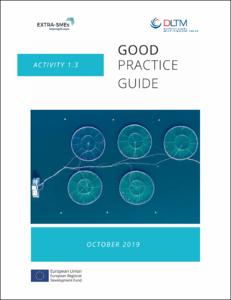| dc.coverage.spatial | European | en_US |
| dc.date.accessioned | 2022-02-20T16:55:34Z | |
| dc.date.available | 2022-02-20T16:55:34Z | |
| dc.date.issued | 2019 | |
| dc.identifier.citation | Distretto Ligure delle Technologie Marine (2019) Good Practice Guide: Activity 1.3. INTERREG Europe, Extra SMEs, 64pp. DOI: http://dx.doi.org/10.25607/OBP-1721 | en_US |
| dc.identifier.uri | https://repository.oceanbestpractices.org/handle/11329/1870 | |
| dc.identifier.uri | http://dx.doi.org/10.25607/OBP-1721 | |
| dc.description.abstract | The EXTRA-SMEs project aims to improve and adapt aquaculture business development strategies
through reflection and analysis, share lessons learned from actual implementation, and implement
large-scale, sustained and more effective interventions to raise sector’s productivity and
competitiveness, based on validated results and evidence. To accomplish this goal, EXTRA-SMEs’
participating organisations are summoned to gather practical insights and share good practices on
various aspects and dimensions of aquaculture business development strategies.
A good practice is a process or methodology that has proven (through experience or research) to
function well within a specific context (geographical or organisation settings), has succeeded in
achieving its strategic and operational objectives, and therefore can be recommended as a reference
model. It refers to a successful experience, which has been tested and validated in practice and
demonstrate high transferability potential. Good practices need to be disseminated and widely
adopted to benefit a greater number of people or/and organisations.
The essence of identifying and sharing good practices is to get inspiration and learn from others, who
have already faced and successfully overcome similar challenges, and to encourage the application of
existing knowledge and experience to new situations. A practice, characterised as “good” should not
be regarded as prescriptive or flawless, nor can it apply to all contexts and conditions. Instead, it needs
to be adapted to the context to respond to site or organisation specific challenges.
This Good Practice Guide (GPG) presents 15 good practices and cases on business strategies and
interventions, which have positively contributed to raising the economic potential and supporting
innovation and extraversion of the aquaculture sector across Europe, and hence can be used as
reference models in similar endeavours.
The Guide aspires to assist project partners and organisations working on economic potential deriving
from aquaculture development in order to increase their efficiency by adopting tools (or components
of them) which have proved to work well in similar contexts, capitalising on existing knowledge. Any
interested bodies will be able to study how these (successful) practices and tools function and
eventually take on those that suit better to the needs and features of their territories – in all cases
localisation and adaptation to individual needs is required.
The Guide is structured as follows. Section 1 describes the main categories of strategies and
approaches to foster aquaculture development and extraversion in aquaculture SMEs, essentially raising the perceived economic potential of the sector as a whole in partners’ regions and across the
EU. Section 2 sketches the methodological framework upon the collection of practices by partners was
realised. Section 3 outlines the approach employed for the identification of good practices, including
a score table with evaluation results. Section 4 presents in details the most successful cases (as
collected by project partners), showcasing the results and accomplishments achieved. Concluding
remarks are finally provided summarising the most important elements of the best practices. | en_US |
| dc.description.sponsorship | European Union; European Regional Development Fund | en_US |
| dc.language.iso | en | en_US |
| dc.publisher | INTERREG Europe, Extra SMEs | en_US |
| dc.subject.other | Aquaculture | en_US |
| dc.subject.other | SME | en_US |
| dc.subject.other | Business development | en_US |
| dc.subject.other | INTERREG Europe | |
| dc.subject.other | Extra SMEs | |
| dc.title | Good Practice Guide: Activity 1.3. | en_US |
| dc.type | Report | en_US |
| dc.description.status | Published | en_US |
| dc.format.pages | 64pp. | en_US |
| dc.contributor.corpauthor | Distretto Ligure delle Technologie Marine | en_US |
| dc.description.refereed | Refereed | en_US |
| dc.subject.parameterDiscipline | Fisheries and aquaculture | en_US |
| dc.description.currentstatus | Current | en_US |
| dc.description.sdg | 14.2 | en_US |
| dc.description.eov | N/A | en_US |
| dc.description.adoption | Multi-organisational | en_US |
| dc.description.adoption | International | en_US |
| dc.description.methodologyType | Guidelines & Policies | en_US |
| dc.description.methodologyType | Method | en_US |
| obps.resourceurl.publisher | https://www.interregeurope.eu/fileadmin/user_upload/tx_tevprojects/library/file_1582293946.pdf | |
 Repository of community practices in Ocean Research, Applications and Data/Information Management
Repository of community practices in Ocean Research, Applications and Data/Information Management
